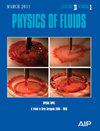Numerical virtual flight investigation for longitudinal maneuver of a generic fighter based on machine learning
IF 4.1
2区 工程技术
Q1 MECHANICS
引用次数: 0
Abstract
Coupled with computational fluid dynamics (CFD), rigid body dynamics (RBD), and flight control system, the numerical virtual flight (NVF) technology can simulate the maneuvering flight process of an air vehicle under control. In this paper, the NVF investigation of longitudinal maneuvers with elevator and thrust vector control is performed for a generic fighter configuration. The rigid dynamic hybrid grid method is taken to realize the motion of the fighter, and the overlapping moving grid technology meets the deflection of the elevator. The Reynolds-averaged Navier–Stokes equations in arbitrary Lagrangian–Eulerian form are coupled with the RBD equations to solve aerodynamics and kinematics problems, while flight control is achieved through an advanced machine learning method. First, the fighter is forced to pitch with the periodic deflection of the elevator, and the unsteady computation is carried out to obtain aerodynamic data. Then, an artificial neural network (ANN) is adopted for aerodynamic identification and modeling, which involves establishing a model between the aerodynamic coefficient and pitching motion parameters. Afterward, the ANN-based NVF is implemented on the basis of the established model and deep reinforcement learning (DRL) is used to design the pitching control law of the fighter. The NVF results based on ANN show that the fighter has a good control effect under the action of the elevator, elevator with open-loop thrust vector, and elevator with closed-loop thrust vector, respectively, as well as the results from the CFD-based NVF system. Finally, the three-degree-of-freedom NVF based on CFD also indicates that the control law designed through DRL has good generalization characteristics. This study demonstrates the potential prospects of machine learning methods in the design and research for a novel generation of air vehicles.基于机器学习的通用战斗机纵向机动数值虚拟飞行研究
数值虚拟飞行(NVF)技术与计算流体动力学(CFD)、刚体动力学(RBD)和飞行控制系统相结合,可以模拟受控飞行器的机动飞行过程。本文针对一般战斗机构型,对升降舵和推力矢量控制下的纵向机动进行了 NVF 研究。采用刚性动态混合网格法实现战斗机的运动,重叠移动网格技术满足升降舵的偏转。任意拉格朗日-欧拉形式的雷诺平均纳维-斯托克斯方程与 RBD 方程耦合,以解决空气动力学和运动学问题,同时通过先进的机器学习方法实现飞行控制。首先,利用升降舵的周期性偏转迫使战斗机俯仰,并进行非稳态计算以获取气动数据。然后,采用人工神经网络(ANN)进行气动识别和建模,包括建立气动系数和俯仰运动参数之间的模型。然后,在建立的模型基础上实施基于 ANN 的 NVF,并利用深度强化学习(DRL)设计战斗机的俯仰控制法则。基于ANN的NVF结果表明,战斗机分别在升降舵、带开环推力矢量的升降舵和带闭环推力矢量的升降舵的作用下具有良好的控制效果,与基于CFD的NVF系统的结果相同。最后,基于 CFD 的三自由度 NVF 还表明,通过 DRL 设计的控制法则具有良好的泛化特性。本研究展示了机器学习方法在新一代飞行器设计和研究中的潜在前景。
本文章由计算机程序翻译,如有差异,请以英文原文为准。
求助全文
约1分钟内获得全文
求助全文
来源期刊

Physics of Fluids
物理-力学
CiteScore
6.50
自引率
41.30%
发文量
2063
审稿时长
2.6 months
期刊介绍:
Physics of Fluids (PoF) is a preeminent journal devoted to publishing original theoretical, computational, and experimental contributions to the understanding of the dynamics of gases, liquids, and complex or multiphase fluids. Topics published in PoF are diverse and reflect the most important subjects in fluid dynamics, including, but not limited to:
-Acoustics
-Aerospace and aeronautical flow
-Astrophysical flow
-Biofluid mechanics
-Cavitation and cavitating flows
-Combustion flows
-Complex fluids
-Compressible flow
-Computational fluid dynamics
-Contact lines
-Continuum mechanics
-Convection
-Cryogenic flow
-Droplets
-Electrical and magnetic effects in fluid flow
-Foam, bubble, and film mechanics
-Flow control
-Flow instability and transition
-Flow orientation and anisotropy
-Flows with other transport phenomena
-Flows with complex boundary conditions
-Flow visualization
-Fluid mechanics
-Fluid physical properties
-Fluid–structure interactions
-Free surface flows
-Geophysical flow
-Interfacial flow
-Knudsen flow
-Laminar flow
-Liquid crystals
-Mathematics of fluids
-Micro- and nanofluid mechanics
-Mixing
-Molecular theory
-Nanofluidics
-Particulate, multiphase, and granular flow
-Processing flows
-Relativistic fluid mechanics
-Rotating flows
-Shock wave phenomena
-Soft matter
-Stratified flows
-Supercritical fluids
-Superfluidity
-Thermodynamics of flow systems
-Transonic flow
-Turbulent flow
-Viscous and non-Newtonian flow
-Viscoelasticity
-Vortex dynamics
-Waves
 求助内容:
求助内容: 应助结果提醒方式:
应助结果提醒方式:


